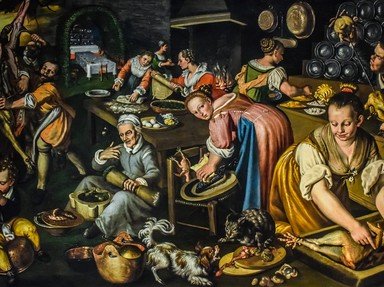Quiz Answer Key and Fun Facts
1. Much art of the Renaissance conveys sublime beauty, exuberant well-being, and prosperity. Which word does not describe a renaissance?
2. To display art during the Renaissance increased personal prestige. Even better, request that an artist create a unique work just for you. This was called by which originally Latin term?
3. Raphael and Claude Monet are well known artists of the Renaissance.
4. The Renaissance was about thriving in a good world. Which spiritual agents were commonly seen in the art of the time, lingering near humans to divinely comfort and watch over us?
5. During the Renaissance there lived an animal well known to us today, but rarely painted before the 14th century. Which brave and steadfast pets signified loyalty and wealth in this art?
6. Many of the great Renaissance artists came from which city of ease, named from the Latin for blossom or flourishing?
7. During the Renaissance there was extended a certain compassion toward a group typically spurned. Which decidedly uncomfortable and doomed population got their own comfort crew?
8. During the Renaissance many painters are in love with love, both heavenly and earthly. Which ancient and romantic god shows up in a great many paintings?
9. Spiritual or religious love and the comforts it offers are common themes in Renaissance art. Madonna and Child was painted countless times. What is a bit disconcerting about most babies painted during the earliest Renaissance?
10. The Netherlands had its own style of Renaissance art. Which of these is a prominent "low country" master, known for multiple depictions of the Virgin Mary as an embodiment of comfort to the devout?
11. Conveying posh and imposing status in Renaissance paintings, which of these may be shown as rich, crisp, glossy and regal, or soft and jammies comfortable?
12. Sidney Harold Meteyard (1868-1947) was a member of the Pre-Raphaelite Brotherhood, an anti-Renaissance group. Still, Meteyard painted a moving scene where which of these provides comfort to the embodiment of Love? When the wrong answers escape it's the only one left.
13. Renaissance artist Paolo di Dono is known as Uccello, "little bird", because of his love for nature and animals. Uccello had a special ability to hearten his viewers because he could accurately portray which of these?
14. Today we might say chicken soup, barbecued ribs or curried rice do the trick, so too Renaissance painters presented viewers with which kind of comfort?
15. Whether Renaissance or any other period, Art is a soothing balm to humans in that it evokes emotion, connection, imagination and awareness, as well as which of these universals?
Source: Author
Godwit
This quiz was reviewed by FunTrivia editor
looney_tunes before going online.
Any errors found in FunTrivia content are routinely corrected through our feedback system.
